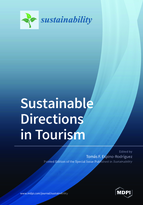Sustainable Directions in Tourism
A special issue of Sustainability (ISSN 2071-1050). This special issue belongs to the section "Economic and Business Aspects of Sustainability".
Deadline for manuscript submissions: closed (30 June 2019) | Viewed by 106335
Special Issue Editor
Interests: outsourcing; service operations; tourism management; hospitality management; supply chain management
Special Issues, Collections and Topics in MDPI journals
Special Issue Information
Dear Colleagues,
Within the framework of tourism companies and tourist destinations, the question of sustainability is gaining importance. Tourists are increasingly aware of the importance of sustainability criteria, awarding greater value to sustainable destinations. Sustainability refers to a wide range of aspects related to climate change, the economic organization of tourism, social values or questions, job creation, and the necessary protection of the culture of destinations and the environment. Therefore, there is a need for studies that consider these aspects in order to achieve a sustainable development of tourist destinations. It is fundamental to discover to what degree tourism companies and destinations approach these questions in the strategies they use to deal with problems stemming from their attempts to be more sustainable. Conceptual papers and empirical research on economic, social, cultural, and environmental aspects related to tourism companies and destinations are welcome. Studies that analyse how these questions and the concept of sustainability are included in tourism companies and destinations are necessary in these modern times. For this reason, this Special Issue will be launched, dedicated to examining sustainability. The papers included in this Special Issue can help us to determine the new directions being addressed in the research on sustainability tourism.
Dr. Tomás Espino-Rodríguez
Guest Editor
Manuscript Submission Information
Manuscripts should be submitted online at www.mdpi.com by registering and logging in to this website. Once you are registered, click here to go to the submission form. Manuscripts can be submitted until the deadline. All submissions that pass pre-check are peer-reviewed. Accepted papers will be published continuously in the journal (as soon as accepted) and will be listed together on the special issue website. Research articles, review articles as well as short communications are invited. For planned papers, a title and short abstract (about 100 words) can be sent to the Editorial Office for announcement on this website.
Submitted manuscripts should not have been published previously, nor be under consideration for publication elsewhere (except conference proceedings papers). All manuscripts are thoroughly refereed through a single-blind peer-review process. A guide for authors and other relevant information for submission of manuscripts is available on the Instructions for Authors page. Sustainability is an international peer-reviewed open access semimonthly journal published by MDPI.
Please visit the Instructions for Authors page before submitting a manuscript. The Article Processing Charge (APC) for publication in this open access journal is 2400 CHF (Swiss Francs). Submitted papers should be well formatted and use good English. Authors may use MDPI's English editing service prior to publication or during author revisions.
Keywords
- tourism and sustainability
- economic organization of tourism and tourism firms
- culture and tourist destinations/tourism firms
- environment and management of tourist destinations and tourism companies
- values and tourism
- employment and tourism






